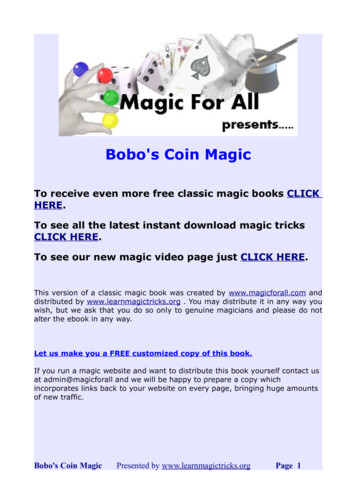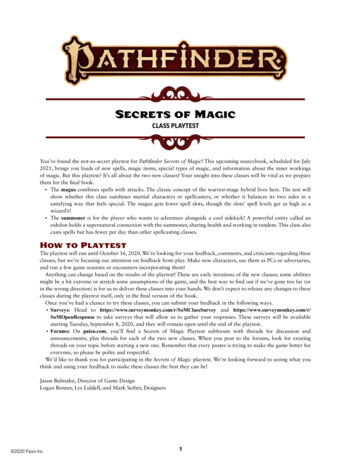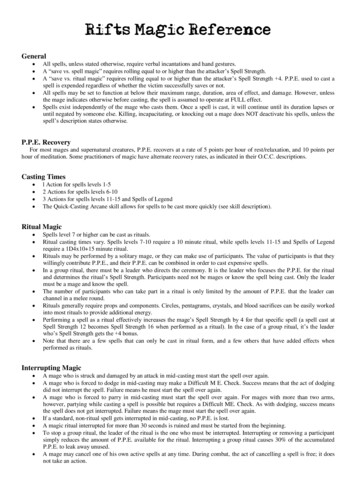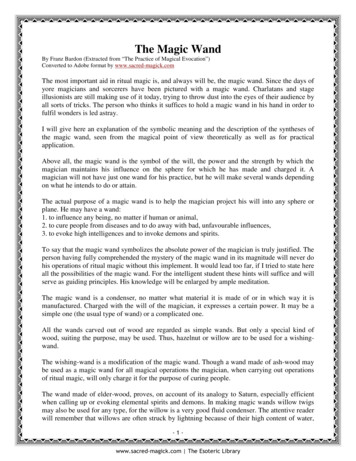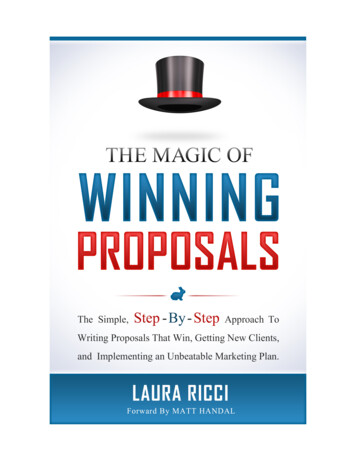
Transcription
THE MAGIC OFWINNINGPROPOSALS
THE MAGIC OFWINNINGPROPOSALSThe Simple, Step-By-Step Approach ToWriting Proposals That Win, Getting New Clients,and Implementing an Unbeatable Marketing Plan.LAURA RICCI, M.B.A.Edited By: MATT HANDAL
Help Everybody Everyday200 Laydon LaneWest Chester, PA 19380Copyright 2014 by Matthew HandalAll international rights reserved. No part of this book or electronicfiles may be reproduced or used in any form or by any means,electronic or mechanical, without permission from thePublisher. Reproduction of up to 100 words for the purposeof published review is acceptable to the publisher withnotice by mailing a copy of the published review to Matt Handal,200 Laydon Lane, West Chester, PA 19380.First Edition 1998 by R3 publishing.Second Edition 2000 by R3 publishing.Third Edition 2006 by R3 publishing.Fourth Edition 2010 (electronic publication) by R3 publishing.Fifth Edition 2014 by Matthew Handal.LCCN 98-093370Library of Congress Cataloging-in-Publication DataRicci, LauraThe Magic of Winning Proposals / Laura Riccip.151 cm1. Marketing and Sales2. Marketing Management3. Management: Organizational Change4. Management: Organizational Effectiveness5. Sales Training and EducationISBN 978-0-9854110-1-5Printed in the United States of AmericaTypeset by Wordzworth.comEdited by Matt HandalEarlier editions edited by George Wilkerson
The high point in the story of Peter Pan comes whenTinkerbell is dying and Peter turns to the audience and asksthose who believe in fairies to exclaim that belief, becausethat’s what keeps Tinkerbell alive. Unfortunately, there arethose adults who believe that a winning proposal is alsomagical. “All you have to do is believe,” they say. “It’slike magic; some people have the touch, and some don’t.”Well, the fact is that Winning Proposals isn’t magic at all.But there is some fairy dust in every proposal that wins.The good news is that no one owns the fairy dust; anyone canuse it to write a Winning Proposal. This manual uses someof that fairy dust, and if you use these tools, the next timeyou write a proposal, you’re likely to have people believingthat you have found the fairy dust, too.
ForewordPrepare to have your mind blown.My desk is littered with piles of business books. Even my Kindleaccount has its own virtual pile of books. Some of them werebought. Some were gifts. Others were sent to me in hopes Iwould provide an endorsement.Each of these books has a common thread that ties them alltogether. They are all half read. For whatever reason, after afew chapters (or even a few pages), I decided my time wasbetter spent doing something other than reading the rest ofthat book.So, why have I read The Magic of Winning Proposals from “coverto cover” so many times? I want to share my perspective on that.What if someone wrote a book that provided the exact strategiesthe Coca-Cola Company or the Walt Disney Company use tobeat their competition? And what if, in addition to that, thisbook contained the systems and forms they use to create thisadvantage? These are multi-billion-dollar corporations thattoday seem almost unbeatable. If it were ever written, that bookwould instantly appear on the New York Times Best Seller List.People would kill for that information, right?Now consider this. The book before you provides the exactstrategies multi-billion-dollar consulting firms (among them atleast two of the top ten engineering consulting firms in the world)use to beat their competition. In addition, this book contains thesystems and forms they use to create this advantage. Yet, in theten years since it was first written, you’ve never heard of it. Youdidn’t even know it existed. And neither did I.
I stumbled upon this book like a clumsy sailor would stumbleonto a hidden treasure chest. It was never published as a hardcover or paperback book. Rather, it was used as a trainingmanual for some of the top consulting firms in the world.Towards the end of her career, in 2010, Laura Ricci quietlypublished her manual as a digital book.If I had not stumbled upon Laura’s website in 2011, I probablywouldn’t have known this book existed. If I wasn’t reading everybook on the topic of proposals because I was writing my own, Imight not have been willing or interested in reading it. And if Ihadn’t reached out to Laura, like you, I wouldn’t have trulyunderstood what I held in my hand.There are other books out there about winning competitiveprocurements. But what makes The Magic of Winning Proposalsso much more useful is it doesn’t just explain how to writeproposals. It holds your hand and takes you through an easy-toread, step-by-step, process.providing the forms to fill out alongthe way. It’s almost like she does the hard part for you.I subtitled the book, The Simple, Step-By-Step Approach ToWriting Proposals That Win, Getting New Clients, and Implementing an Unbeatable Marketing Plan because Laura’s guide towriting proposals is sandwiched in a no-nonsense approach tomarketing your service-based firm.Once you read this book, you’ll understand why I have suchreverence for it and why we are all so lucky that Laura allowedme to pursue a dream.getting this book in as many hands aspossible.MATT HANDALAuthor of Proposal Development Secrets
Contents1NOW YOU SEE IT; NOW YOU DON’T: WHY YOUR MARKETINGMIGHT NOT WORK AND WHAT TO DO ABOUT ITWhy Spend Money on Marketing?Customer CASEs218THE PROCESS WINNERS USE TO WIN: HOW TO SET UPSYSTEMS THAT WILL LEAD TO MORE CONTRACTSStrategy and Analysis First11Identifying the Buyers15The Marketing Plan: A Process, Not a ProductFour Types of Buyers (BUGS)Issues of Critical ImportanceISSUEs of Critical ImportanceIdentifying the Gaps in KnowledgeMaking an Action PlanBlack Hole Report311161818202223HOW TO FIND THE REAL CLIENTS AND GET INSIDE THEIRHEAD (EVEN WHEN YOU DON’T KNOW WHERE TO START)Identifying the Client Target25Go/No-Go Decisions27Setting the Goal for Your MeetingsMarketing Meeting WorksheetReviewing the Meeting Results272829
Looping Back to Strategy and Analysis30Analyzing the ISSUEs32Comparing Strategic and Tactical Elements of MarketingCheck Out the BUGSReview Your GO/NO-GO ChecklistGO/NO-GO Checklist4Moderator Notes for a Theme Meeting34353744CRAFT A COMPELLING PROPOSAL BY STEALING FROM THEHOLLYWOOD PLAYBOOKStoryboardsHow To Use StoryboardsA Sample StoryboardHow to Save Money on ProposalsStoryboard632THE BIG BUILDING TECHNIQUE: THE PROPOSAL TACTICFIRMS USE TO HACK THEIR CLIENTS’ MINDSThe Magic of a Theme5314748495253THE PROPOSAL PROCESS THAT WILL SAVE YOU MONEY,PROTECT YOUR INTERESTS, AND GIVE YOU AN EDGE OVERYOUR COMPETITIONCost ProposalReviewing the Cost ProposalThe Request for ProposalsBreaking Down and Summarizing the RFPExample of a Proposal Summary5557575860
Setting a Schedule: Don’t Try to Pull a Rabbit Out of a Hat66Distribution of Authority70Sample Schedule68Enforcing Security73Unfriendly Ghosts and Goblins79Database Resources76Writing the White “Draft”82Proposal Graphics86StoryboardThe White Team ReviewExample of Helpful CommentsExample of Useless CommentsExample of a Complete Storyboard8588909192Writing Style93The Pink Team Review99Writing the Pink “Draft”97Writing the Final Draft101Publication and Delivery Management104The Red Team ReviewComparing Strategic and Tactical Elements of ProposalManagement7102106THE SHORTLIST SOLUTION: HOW NON-ACTORS CAN PULL ARABBIT OUT OF THE HATBest and Final OfferOral Proposals107113
8HOW TO WIN EVEN IF YOU’VE LOSTInternal Proposal TeamClient DebriefsBlack Hole ReportFour Types of Buyers (BUGS)Customer CASEsGO/NO-GO ChecklistISSUEs of Critical ImportanceMarketing Meeting WorksheetSample ScheduleStoryboardComparing Strategic and Tactical Elements of MarketingComparing Strategic and Tactical Elements of ProposalManagementModerator Notes for a Theme Meeting117121128129130132134135136137138139140
ONENow You See It; Now You Don’t:Why Your Marketing Might NotWork and What To Do About ItWhy Spend Money on Marketing?Picture this: A man walks up to you on the street. He’s nicelydressed, clean-shaven, and well groomed. “Excuse me,” he says,“I wonder if I might have a minute of your time to talk to youabout how I can save you a great deal of money.”What do you do?1 Step around him and keep on walking.2 Say “Excuse me, I’m in a hurry,” then step around him andkeep on walking.3 Say to him “Of course I’m interested. Please tell me more.”Unless you’re a very unusual sort of person, you’ll do 1. or 2. Butwhy? Well, regardless of how he’s dressed or how polite he acts,you don’t know him.1
2 THE MAGIC OF WINNING PROPOSALSNow consider this. The next day you see him on the elevator inyour office building. He smiles and nods. Do you smile back?Perhaps. Or maybe you’re just trying to place him. “Ah yes,” youthink. “It’s that fellow from the street.”That evening as you and the others in your car pool are leavingthe building, you see him again. This time he’s getting into hiscar (a Mercedes convertible). He waves at you. Do you waveback? Maybe weakly perhaps, but you now feel obliged toacknowledge his presence. You turn to the others and ask: “Doesanyone know who that is?”“Sure,” one of them says, “That’s the guy from Robbletussen andJalinsky the marketing firm downstairs.”And let’s say this continues for a couple of days. You see him andhe nods or waves each time until one day, he approaches youagain. “Say there my name is Bob. I just wondered if there isn’tsome time when I might talk to you. It will just take a minute.”“Well er ”“I really believe I might be able to save you a great deal of money.”And now, perhaps, you feel you can give him, at the very least, aminute of your time.The Two Keys: Credibility and RepetitionThere are two reasons why most of us would finally succumb tothe man’s request: credibility and repetition. No one wants to dobusiness with someone they’ve never met nor heard of. Andrepetition is necessary for us to make a place in our minds torecord information about an opportunity. We remember thingsin context, and only after many contacts do we create a spot inour memory that is anchored to the person rather than thecontext surrounding that person.
NOW YOU SEE IT; NOW YOU DON’T 3Marketing recognizes these principles. They form the foundation for any kind of solid marketing plan. We need to spendmoney on marketing because it’s not good enough to just deliverthe message about your services and capabilities once. In orderfor your reputation to be created, you must repeat the messageover and over and in different ways.Marketing research shows that it takes at least 7 exposures formost people to buy something.And it takes at least 12 exposures for most people to be able toremember one offer as distinct from another. Since credibility isthe first requirement for any sale, the first goal in exposure is toestablish yourself or your business as credible. And becauserepetition is the second requirement, you need to establish acontext for yourself. Both of these critical elements take time andmoney. But if it’s done right, it’s well spent.Getting to the Top of the Magic WandThe human brain stores information by categories on “rods” or“wands.” Just to get assigned to a wand, we must have at least 3(but more often 7) exposures. So, if one of the wands is “neighbors” and you move into the neighborhood, a few exposureswill establish a place for you on your neighbor’s wand. But forhim to cite you as the first neighbor that comes to mind whensomeone says “neighbors,” you’ll need many more exposures tomove to the top of his “neighbors” wand.Remember: exposure is always contextual at first. We use thetime or place as a common theme to the detail of a face. Onlyafter many more contacts do we create a spot in memory that isanchored to the person rather than the context surrounding thatperson.
4 THE MAGIC OF WINNING PROPOSALSIt gets even more difficult if you want to be on a new wand,under a new category. It takes at least 12 exposures to create anew wand. So, if you want to be thought of as the number onebabysitter, you’ll need 12 or more exposures (in addition to theexposures that put you in the “neighbor” category) to get thisaccomplished.And varied exposures work best. People make the connections indifferent ways. So if you want to be most effective, you’ll have tosend your message in different ways. Some people connect with agood description, some with a good picture, and others with agood handshake. But each style of exposure adds to the requiredtotal. While a person-to-person contact is the strongest, otherstyles of contact can increase your exposure as well.Good Work Is Not EnoughA new family moves in, and very soon several neighbors stopin to introduce themselves. They learn that the new familyhas a young son who’s interested in playing baseball, and theparents are concerned about whether they’d arrived too late tojoin the Little League. The wife has just been learning Asiancooking and wonders if there’s an Asian market in the newcommunity. The husband enjoyed playing racquetball wherethey last lived, but doesn’t know whether he’ll be able to takeit up here or not.The first neighbor hears all of this and says, “I have just whatyou need,” and returns a while later with a stack ofnewspapers and magazines. “Here’s everything I have thatmight be of interest to you. It’s the last two years of the citymagazine and the last six months of the local newspaper.Everything you need to know is in here!”
NOW YOU SEE IT; NOW YOU DON’T 5The second neighbor hears all of this and says, “I have justwhat you need.” She returns a few days later with 12 pieces ofpaper upon which she has printed out the local little leagueschedules and rules that are posted on the Internet. She’s gotclippings from a news story about Asian cooking classes offeredby an Asian grocery nearby. And finally, she has a magazinearticle about racquetball clubs, with pictures of local courts inthe city.Which neighbor stands out? What makes your organizationstand out? It’s not just the information the neighbors provided,but the quality of that information, the fact that the secondneighbor focused on the specific needs. They may have bothexpended the same amount of energy, but the second neighbor’sefforts were more meaningful to the new neighbors.The fact is, there’s plenty of good work and good workersaround. For every opportunity there are usually several good,well-qualified firms to do the work. Ego may make you believethat you’re the best, but it won’t convince your client. Theyaren’t just looking for someone to help; they’re looking for the“best firm for the job.” And that’s not necessarily the leastexpensive, it’s the one that provides the best value, that is, themost appropriate level of skills at the best price to get the bestresults.Some firms use the encyclopedia approach to marketing. Theyspend lots of money collecting everything they are proud of, andthen deliver it all to the customer. Everything the customerneeds to know about your firm is there, but they have to find it.
6 THE MAGIC OF WINNING PROPOSALSLike the second neighbor, listening to the customer first is thebetter approach. Finding out what they need most and thenproviding exactly the information they are seeking is of greatervalue. And this is how we provide better value in our marketing— focus first on the customer.Spend your money where it will make a difference and avoidwasting money on activities that don’t work. Sounds simple,doesn’t it?Being The Best Is Not EnoughImagine a world where the best always won. There would onlybe one local dentist, one patent lawyer, one tax accountant, andone civil engineering firm. If we only ever chose the best, all theother, lesser, firms would go out of business.If you’ve ever knowingly bought a product or service that wasn’tsimply the best, you can’t deny the best doesn’t always win.A Good Presentation Is Not EnoughA good marketing plan, a slick presentation of marketingmaterials, captivating conference speeches, firm handshakes, andprofessional presence are not enough to win work. That’sbecause there are only a few times when the buyer is really readyto buy. Until that moment, your marketing campaign will notresult in work.A Good Proposal Is Not Good EnoughIn every competitive procurement, someone knows about theopportunity before the Request for Proposal (RFP) comes out.And that someone is, more often than not, the winner.
NOW YOU SEE IT; NOW YOU DON’T 7That bears repeating. In every competitive procurement, someoneknows about the opportunity before the RFP comes out. The winnerknows something the losers didn’t know. They know how to be awinner. They have a system to make sure they are running afterthe “right stuff,” and they don’t waste resources on low probabilitywins. They preserve their resources so they can be lavish with theirtime and attention on the best opportunities.A group of engineers heard about an outstanding proposalanother group in their firm produced that won a huge awardfrom a customer just like theirs. They were very anxious tocapitalize on the success of this other group, so to save themselvessome time, they took that proposal, replaced the customer’snames, and submitted it.They then waited patiently to hear about their magical proposalwinning yet another award. Weeks went by with no word, sofinally, they called to inquire. “Yes,” the customer said, “anaward was made. And the consultant is already on the job.”“What?! That can’t be! What happened?!”What happened was that there was no magic in the secondversion of the winning proposal. The magic was in the firstversion because the magic is in knowing the customer. Knowingyour customers’ wants and desires (not just what they need) andhaving a marketing plan in place to capitalize on your knowledgeworks every time. Your winning proposal is simply the proof thatthe customer was right to select your organization.
8 THE MAGIC OF WINNING PROPOSALSCustomer CASEsThere are generally four cases a customer might be in when they areapproached by someone trying to make them their “First Choice”supplier:Crisis, Arrogance, Satisfaction, or Expansion.noun. 1. An instance or example of the existence or occurrence ofsomething. 2. A set of circumstances or state of affairs; situation.3. A set of reasons, arguments, or supporting facts offered injustification of a statement, action, situation, or thing. V. cased,cas·ing, cas·es. Slang. To examine carefully, as in planning a crime:case the bank before robbing it.A Case of C risisA customer in a case of crisis needs help but isn’t taking the time forcareful consideration that a customer in a case of expansion would.You must do two things with someone in the case of crisis: (1) restrainyourself from telling them that “you told them so” and (2) present aquick fix solution. Only after the crisis is over can you try to discusslonger range, more strategic projects that can prevent the crisis fromever happening again (or uncover other lurking issues due to becomecrises).
NOW YOU SEE IT; NOW YOU DON’TA Case of A rroganceAn organization or customer who is disconnected from reality and doesnot perceive any competitive threat to their position is usually sufferingfrom arrogance, and they will be hostile to anyone who dares tosuggest things are otherwise. Customers with a case of arrogance willnot buy anything, but you should stay close by. Fortunately (for you),arrogance never lasts. Arrogance thwarts the ability of the customer tonotice what is going on around them, and very soon these customerswill most likely be facing a crisis. It’s just a matter of time. (Time, ofcourse, is relative to different industries – in the retail soap trades, verysoon will be within the quarter; in the government, very soon may betwo senatorial terms from now.)A Case of S atisfactionWhen a customer is in a case of satisfaction, there’s very little hope ofwinning work or making a sale. The customer believes that his or hercurrent situation is all right. They don’t feel like looking at other options.For example, the proverbial “retired in place” administrator doesn’t wantto change anything. It’s all downhill for him. The last thing he wants tohear about is a change. So you’re not likely to make a sale here, andshould move on to another better opportunity.A Case of E xpansionA customer (or organization) in a case of expansion sees newopportunities and is looking for new ways to solve problems. You aremost likely to make a sale to a customer in this case. In a case ofexpansion, you are welcome to present new solutions, and you’ll find awilling ear. More importantly, a customer with a case of expansionneeds solutions and suggestions! 9
TWOThe Process Winners Use to Win:How To Set Up Systems That WillLead To More ContractsStrategy and Analysis FirstIdentifying the GoalIt’s an old cliché; that’s why it’s still true: You can’t get anywhereif you don’t know where you’re going. That’s why the onlymarketing activities that succeed are those with thoughtfulconsideration behind them. And marketing will be a major factorthat determines whether or not you are successful in yourproposal pursuits.The Marketing Plan: A Process, Not a ProductYour marketing plan represents a process. It must evaluate all ofthe available opportunities, compare them to the solutions yourorganization can provide, and then take the steps necessary toget you where you want to go.11
12 THE MAGIC OF WINNING PROPOSALSThe Marketing Plan should be clear and have enough detail thatthe managers responsible for selecting specific organizations asmarketing targets can test their selections against the MarketingPlan and have some confidence they are making the right choices.Stage One: Starting QuestionsThe first stage of developing a solid marketing plan requiresasking yourself questions about what your organization doesbest, what it can offer to the marketplace, and what marketplaceyou’re most competitive in.The answers you come up with won’t all be correct. But it’s astarting point. Just about the time you think you’ve got a marketplace figured out, it’ll move on you! So marketing plans areusually only good for one year at the most.If you’re in a dynamic marketplace, or you’re building a marketing plan for a new technology, you’ll be editing and changingthat plan each week as new intelligence is gathered.Stage Two: Organization QuestionsNext you’ll need to ask questions like these about your organization:Where are the best matches between the services/productswe provide and the needs of the marketplace?What’s already working well in the marketplace?Is there an opportunity for us to follow this example becauseof growth in a new region?Where are the gaps in services or products that you may beable to fill?What is not available in the marketplace? How can we verifywhether the need has demand behind it, or is it just a needthat does not have enough demand to overcome inertia?(Remember how strong the pull of inertia is!)
THE PROCESS WINNERS USE TO WIN 13Stage Three: Customer/Client QuestionsYou also need to ask questions about your clients. The best wayto do this is to make two lists that respond to two questions:1 What do your best customers look like and why are they your bestcustomers?Write down the answers to these questions and be specificabout what it is that makes these customers the best, including any cultural attributes that make working with them enjoyable for your organization.2 What do your worst customers look like?Write down exactly why they are on this list, including whatthey do or don’t do that does or does not fit with your organization. Be specific in detailing the points that rub you raw.Maybe their accounting system drives you wild, causing losttime and money trying to get your invoices through theirsystem. Or maybe their internal process for handling reviewsof professional work is chaotic, and this eliminates your margins with their schedule failures.From the two lists, you can now write a description of your idealcustomer. What elements should you be looking for that will bebetter matches for your organization.You may decide to change some things in your organization inorder to better match with some of your customers. Sometimesreorganizing your own accounting systems makes some of theWorst Customers your Best Customers immediately.All of this analysis goes into your marketing plan. And remember, the plan will be fluid to accommodate new information asit’s discovered. Even though goals and targets will shift, theremust a plan. After all, how are you are going to get “there” if youdon’t know where “there” is?
14 THE MAGIC OF WINNING PROPOSALSStage Four: Sharing the PlanThe marketing plan must be shared with everyone in yourorganization. The organization can’t move together unlesseveryone knows what the course is that’s being charted.Your organization is not so much like a ship as it is a bunch ofcanoes lashed together with ropes. The trip can’t be made ifyou’re headed out onto a lake without sharing a target. Wheneveryone knows what the plan is, they can support the plan inthe hundreds of little ways that add up.One organization I worked with set a goal to pare down theircustomer list to the most profitable clients, their top 50.Everyone in the organization was shown the list. One day inthe reception area, a customer from one of the top 50 waswaiting for the same person as a customer from the bottom oftheir client list.Because the receptionist knew where the firm’s priorities were,she gracefully shepherded in the top 50 client without lettingon that she had put her in front of the other client.This is an example of one of those “little hundreds” of waysthat everyone in the organization can contribute to the goal –if they buy into it. If they’re told about it and the informationis shared with the entire firm, you’ll be amazed at the results.When management has the nerve to open up and showeveryone where they are going, there’s no stopping you fromgetting there.Stage Five: Selecting the TargetsAt this stage, the Marketing Managers should be ready to selecttarget organizations for a marketing approach and investigation.
THE PROCESS WINNERS USE TO WIN 15After checking the target against the Marketing Plan, they workto identify how best to infiltrate the target organization andcollect and analyze the intelligence gathered.By first finding out the CASE of the organization and thenidentifying the BUGS and documenting the ISSUES, you can bein a position to decide whether your organization can be a winnerwith this prospect and turn them into a customer or client.Identifying the BuyersManaging the BUGSThe days when just knowing the whims of the CEO wereenough to give you an edge over the competition are over.Marketing for large, complex programs is no longer a singleindividual’s decision. Many people must be enthused or at leastpassive before an award is made. Unless you are De Beers, youdon’t have a monopoly on answering your client’s needs. So wemust be dedicated to collecting the information from everyonethat together makes up the “needs” of the customer.One thing that really BUGS organizations is figuring out whatthe folks in the client organization are going to do next. Byanalyzing the target organizations, the BUGS, or buyers, can bestrategically managed.That’s a lot of folks to talk to! But if you’re selling a complexproduct or service to a large organization, understanding the roleof each of these buyers is critical. You must get to know themwell enough to focus your proposal appropriately.One of the reasons that your incumbent competition is hard tounseat is that more than just one person needs to be convincedthat a change would be good. And they all must reach that sameconclusion at a moment that is appropriate to bring in a neworganization.
16 THE MAGIC OF WINNING PROPOSALSFour Types of Buyers (BUGS)There are just four types of buyers. I call them the B osses, the U sers, theGatekeepers, and the S upporters. They’re the BUGS you must learn tomanage.BossesThese are the ones who hold the purse strings of the organization. Ifthings have been done one way for a long while, a Boss can move theorganization (and the attendant budgets) in another direction. So it’sabsolutely critical that they be identified for every prospective sale. Youneed to know what the Boss’s intended path is so you can craft yourproposal to match their direction.UsersThese folks want to know that your proposal will work for them and solvethe problem they are responsible for managing because they have todeal with the day-to-day details. You need to know what their operatingenvironment is like so you can meet their needs with your proposal.
THE PROCESS WINNERS USE TO WIN 17GatekeepersThese people can say “No” but they can’t say “Yes.” Their function is tomonitor the process and make sure your proposal meets the requirementsof the organization. They often want to be identified as Bosses, but youcan often identify them as Gatekeepers because they’ll tell you thatthey’re the final decision-maker. “Yessir,” they’ll say, “the buck stopshere. The folks upstairs just ‘rubber stamp’ my decision.” This attitudemakes them dangerous because if you take them at their word andbelieve they really ARE Bosses, you’ll never find out what the Bossupstairs REALLY wants. Gatekeepers are important to the process (they’llmake sure you know that!) but they aren’t ever the only Buyer in anorganization.SupportersThis might be a User who became enamored of the product at ademonstration, or someone who has worked with you before and feelsyour work would be a good value for their organization. They’re familiarwith your solution and want to see it applied in their organization, andyou should enlist their help. But rather than trying to sell them, youshould use them to coach you on who the players are for the targetproject in front of you.
18 THE MAGIC OF WINNING PR
THE MAGIC OF WINNING PROPOSALS The Simple, Step-By-Step Approach To Writing Proposals That Win, Getting New Clients, and Implementing an Unbeatable M
